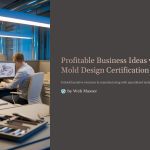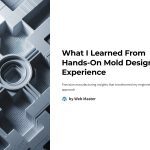 In the fast-evolving world of precision manufacturing, hands-on mold design isn’t just a technical task — it’s a strategic edge. As CAD/CAM systems advance and product life cycles shorten, the ability to design a mold that delivers flawless production on time is becoming a rare and highly prized skill. Over the past decade, my experience in real-world mold design has taught me far more than CAD shortcuts or injection flow principles. It shaped the way I think, approach challenges, and ultimately, create solutions that last. Today, I’ll share the transformative lessons that you won’t find in textbooks — the kind of insight only the floor, the machine noise, and late-night iterations can teach you.
In the fast-evolving world of precision manufacturing, hands-on mold design isn’t just a technical task — it’s a strategic edge. As CAD/CAM systems advance and product life cycles shorten, the ability to design a mold that delivers flawless production on time is becoming a rare and highly prized skill. Over the past decade, my experience in real-world mold design has taught me far more than CAD shortcuts or injection flow principles. It shaped the way I think, approach challenges, and ultimately, create solutions that last. Today, I’ll share the transformative lessons that you won’t find in textbooks — the kind of insight only the floor, the machine noise, and late-night iterations can teach you.
These lessons are especially critical in 2025, as manufacturers globally shift toward tighter tolerance requirements, faster prototyping, and digital twin integration. Understanding what truly matters in mold design — beyond tolerances and cooling systems — can be the difference between a good engineer and a great one.

Embrace the Imperfection of Prototypes
One of the first lessons I learned in mold design was to not fall in love with the CAD model. The perfect mold on screen rarely behaves as expected in real-world applications. Early in my career, I designed a high-precision electronics housing mold with optimized cooling and flawless draft angles. Yet, during trial, it warped due to unexpected polymer shrinkage behavior.
This experience taught me the importance of prototyping — not just to validate geometry but to observe material behavior under pressure, heat, and time. Even digital simulations can’t fully replicate how materials flow or cool inside a mold. The key is to treat each prototype as a learning point rather than a failure. Every flaw brings you closer to the optimal solution, especially in multi-cavity molds or parts with high surface finish demands.

Tolerance is a Language — Speak It Fluently
In the mold design world, tolerance isn’t just a number. It’s a negotiation between design intent, material behavior, and machining capability. One early mistake I made was using too tight a tolerance on non-critical features, which drove up machining costs without adding value. Understanding which dimensions are critical to function and which are not can save not only budget but also reduce lead time and rework cycles.
Tolerance stacking, draft analysis, and interference fits are not merely mechanical details — they are the language that bridges designers with toolmakers and quality inspectors. A fluent understanding of GD&T (Geometric Dimensioning and Tolerancing) makes your drawings readable and your intentions executable. Never underestimate the power of a well-dimensioned drawing.

The Underrated Power of Mold Flow Analysis
Mold flow simulation is often treated as an afterthought — something to check off before tool manufacturing. But using mold flow analysis as an iterative design tool rather than a validation step changed the game for me. When properly used, it helps identify weld lines, air traps, sink marks, and cooling inefficiencies before they become production nightmares.
Through tools like Autodesk Moldflow or Siemens NX, I was able to redesign gates, runners, and cooling channels proactively. In one instance, this reduced a tool modification cycle from three to zero. It’s not about trusting software blindly — it’s about combining simulated intelligence with physical intuition.

Communication With Toolmakers Is a Skill
I once believed that the better my drawing, the less I needed to talk to the toolmaker. I was wrong. Real-world collaboration with toolmakers taught me that the best designs come from feedback loops. A drawing might be technically correct but practically inefficient. Talking to the machinists often saved me from unmanufacturable features or tolerance nightmares.
One of my biggest takeaways was the importance of DFM (Design for Manufacturability) meetings. They aren’t optional — they’re vital. Spending time discussing ejection angles, insert strategies, and polishing zones led to far better final products and fewer delays.

Heat Management is Half the Battle
In injection molding, it’s not just about getting plastic into the cavity — it’s about controlling how it cools and exits. Poor cooling design can increase cycle time, warp parts, and even cause early mold wear. In a consumer electronics project, I saw a 30% reduction in cycle time just by adding conformal cooling near the core area.
Thermal management is rarely visible in the CAD, but it’s the secret hero of efficient molding. Whether using baffles, bubblers, or conformal cooling from metal 3D printing, understanding the thermal path changes everything. Don’t underestimate thermal simulations — they make or break high-volume tools.

Ownership Mentality Makes You Indispensable
Beyond the CAD skills, software proficiency, or material knowledge — the most valuable trait I’ve developed is ownership. Treating every mold as if it were my investment changed how I approach design, timeline, and quality. I followed up after trials, visited the shop floor, and asked operators what went wrong — even when I wasn’t responsible.
This behavior built trust, refined my decision-making, and made me someone people relied on during launch crises. Mold design isn’t just a task — it’s part of a larger product success story. Those who take ownership are the ones whose careers grow fastest and whose insights are remembered.
*Capturing unauthorized images is prohibited*




